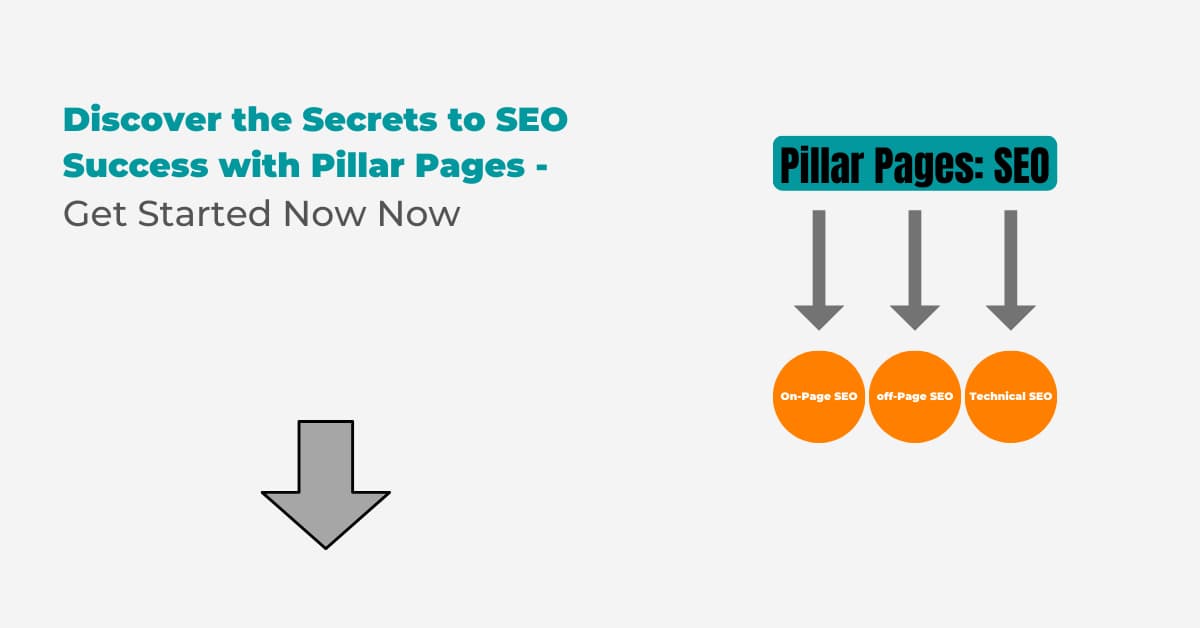Reading Time: 7 mins 40 sec
In this article, we are discussing what is a pillar page and why it matters for your SEO.

In brief,
“However, not all online content is king-worthy, and over 90% of websites do not get any visitors from Google. Use content cluster and pillars page strategy to rank on page 1 of Google to get your content out to the masses and stand out from the crowd. Create purposeful content that is relevant and valuable to the reader.”
Quality content is essential if you want to increase your company’s industry authority, organic visibility, and position.
Page optimization and blogging are crucial components of any SEO plan.
Yet, when used properly, a topic-based SEO approach can raise the bar for you.
So let’s get started
Read This: How To Show Favicon In Google Search
What Is A Pillar Page And Why It Matters For Your SEO
Today, Content reigns supreme in society.
In fact, according to Internet Live Stats, more than 8 million blogs are published daily.
Unfortunately, not all online content is king-worthy, and over 90% of websites receive zero visitors from Google.
In addition to this massive avalanche of content production, people’s search habits have evolved as well.
Gone are the days of optimizing blog content to rank for long-tail keywords – conversations and precise search queries are primarily entered when people visit Google and other search engines.
People want to find what they’re looking for quickly and accurately.
And search engines are working hard to give people what they want by adjusting their algorithms to consider these “interactive searches” as an idea rather than as individual keywords.
This means that if you want to appear on page 1, the content you create needs to address the maximum number of searches related to the particular topic you want to rank for.
So what actions do you need to take to spread the word about your story and stand out from the crowd?
Creating content with a valuable purpose for the reader.
Developing a solid content cluster and SEO pillar strategy to ensure that your content sees the light of day.
In this article, we will provide you with some pillar page examples and explain how using content groups and pillar page strategy can get you ranked on page 1 of Google.
But for good or bad, this non-stop production of content isn’t likely to slow down anytime soon.
How Does a Pillar Page Work?
To understand pillar pages, you must first be familiar with the SEO pillar strategy and the idea of content groups.
So, what exactly is a Content Cluster? A content group is, in the simplest sense, a network of related content.
Each piece of content in the cluster works as a whole to address each query your audience is trying to find. A group of related pieces of material.
- Three thousand words or so per column page.
- 2,000 words or so for the support column.
- 750 words for a blog.
The centerpiece of a page content group is a column.
Pillar pages serve as an in-depth resource for a specific topic on which you are an authority and want to rank higher.
Your smaller support columns and blogs can use related subtopics, link back to the main column page, and you can choose to have those subtopics as well.
By providing a broad and easily accessible network of content for your chosen topic, this pillar strategy enables you to get as much traffic from Google as possible.
Read This: Protect Your Website Content From ChatGPT
Why Use Pillar Pages?
We’ll divide our response into two parts:
First, pillar pages enable you to group your content into categories based on topics and lead site visitors to other pages for more information.
As a result, both users and Google will find it much easier to browse and navigate your website.
Use pillar pages to make sure your pages lead to the objective you focus on most.
Your pillar page, more importantly, determines how your website will develop.
It is similar to deciding what will be the theme of your website to map the pillar pages and cluster pages.
Secondly, pillar pages have many advantages in terms of SEO.
The high-quality content organization improves your search engine rankings.
Because when it comes to content, quality always wins.
Google’s algorithm makes a concerted effort to solve this problem by prioritizing websites with a clear user interface and logical hyperlinking.
If Google can determine what each section of your content is about, you will be ranked better.
You can think of it this way: The more you write about a particular topic on your website, the higher your overall rank for that topic will be.
Finally, hyperlinking and content creation focused on relevant topics and subtopics are SEO benefits of pillar pages.
The history of pillar pages
Before HubSpot’s invention of the term “pillar page” in 2017, many SEO and marketing professionals were discussing content structures with a similar layout.
Things like “cornerstone content” and “skyscraper content” were all variations on the pillar pages, with only minor changes in the way these pages were featured and arranged.
The tall page becomes a central hub around which pages on related topics are concentrated, which is the main difference between it and the column page in comparison.
The usefulness of this structure has changed as a result of Google’s use of artificial intelligence (AI) to better understand web pages and its increased focus on user metrics.
As a result structure and utility became more important.
Why It Matters For Your SEO
Improving user experience is the primary marketing and SEO benefit that pillar pages provide.
Because it increases dwell time, average page views per user, and other user metrics, a better user experience is good for SEO.
On the other hand, pillar pages also provide some direct SEO benefits.
One of the main benefits of pillar pages is that they make it easier to build more relevant internal links.
Although internal linking is important for SEO, many SEOs and webmasters ignore it.
When working with pillar pages it is easy to add enough relevant internal links to attract users and pass them link authority for your website.
Working with column pages has the added benefit of preventing the occurrence of orphan pages.
Orphan pages are almost always deleted when they occur accidentally, often receiving less traffic and rankings due to poor indexation, so avoiding them is an important component of SEO.
A final advantage includes AI and topical relevance.
Many SEOs think that the fact that your pages are clearly organized around particular topics helps search engines understand your site and the different pages that make it up.
One of the most important aspects of SEO is making sure you know what your page is about, as page relevancy is a major ranking factor.
Read This: How Long Does It Take To See Good Results From SEO?
How to create a pillar page?
1. First, decide which subjects you wish to rank for
Choosing the topics you want to rank for is the first step in developing content groups and pillar pages.
The intent is to think about broad topical topics, rather than using specific keywords.
Ideally, your article should cover enough ground to warrant several blog posts, while still being manageable for a one-column page.
For a column page, “Business” is too general.
Most likely, a website cannot cover that much ground.
Make sure the longtail keywords you choose for your pillar page have a lot of search traffic.
However, you can also view trend data.
Is the keyword gaining popularity in your target market, or has its time come and gone?
2. Carry out in-depth keyword research
To find every possible search query for your topic area, do an exhaustive keyword search.
You should have complete information.
The questions your personas ask at each stage of the customer journey should be taken into account, as well as their pain points.
Use well-known tools for keyword research, such as Google Search Console or Answers the Public.
This tool shows the search terms users use to find information on a particular topic.
Using Google autocomplete suggestions and related searches in the “People also asked” section is another way to come up with insightful questions.
This gives you even more understanding of how people search.
3. Arrange keywords according to the blog category
Creating a topic group is difficult, but this is probably the hardest part.
This is, by far, the most important step to master.
If you don’t group your keywords correctly then your group pages will be too broad, too narrow, or too similar and will not rank well.
Use the overall theme or focus of the blog as a starting point for organizing keywords.
Try grouping them together based on the most appropriate keywords for each category.
Don’t be afraid to get creative with categories – sometimes the best way to sort keywords is to come up with non-traditional or niche groupings that will set the blog apart.
4. Create the cluster pages
You should have finished most of your cluster pages before creating column pages.
When the information is already there, it is much easier to summarize it.
If you draft your column page first, you’ll feel obligated to include too much detail, making clustered pages unnecessary.
When creating your cluster pages, keep the following in mind:
- Make sure your pages are navigable and well organized.
- Use language that is clear and concise.
- Use images and multimedia, to break up the text and add visual interest.
- To further expand your topic, use external links.
- Update your pages frequently with new content.
5. Create your pillar page
When creating your pillar pages, keep the following two things in mind:
To allow for further discussion in your group pages, keep subtopics brief.
Provide the reader with enough information to be useful.
Mastering can be challenging.
If you go into more detail on each subtopic, it will be easier to convince readers and Google that you have adequately addressed their query.
Long-form content pieces, called “pillar pages”, usually cover a single topic in depth.
Before writing a column page, you must thoroughly research your topic and put it in a digestible format.
Once you have gathered all your data, the writing of your column page can begin.
Provide lots of examples, illustrations, and data to support your arguments.
Read This: How To Use Seo For Youtube
Conclusion
In this article, we are discussing what is a pillar page and why it matters for your SEO.
The main topic is covered in great detail on pillar pages, also known as top-level content.
They provide readers with a one-stop shop for all their information needs by linking to in-depth articles about particular sub-topics.
While nothing new, pillar pages are now an important part of any SEO strategy.
Pillar pages are a necessity if you want to enhance your SEO strategy.
I you like this article please share and comment.
Read Also
- Top 65 Technical SEO Interview Questions And Answers
- Does Bold Text Help SEO
- How To Create The Perfect H1 Tag For SEO
- Google Announces Five Changes Coming To Mobile Search
- Benefits Of Using Semrush
FAQ
Why are pillar pages important for SEO?
Ranking for difficult keywords.
Additionally, when pillar pages rank, they gain traffic, backlinks, and SEO power. They also increase the rank of the cluster pages they are linking to as an added benefit by passing “link juice” to those pages.
What is pillar post in SEO?
The content that forms the cornerstone of a topic group is called a pillar page or pillar post. They give a complete overview of a broad topic and include links to material on related topics. For example, imagine you want to create a topic group on SEO. An entire article outlining the fundamentals of SEO can serve as your pillar page.
What is the definition of pillar page?
A column page, also known as a content column or power page, is a web page that comprehensively discusses a broad topic and links to groups of related content.
Why do Pillar pages help websites rank well?
Column pages make it relatively easy for websites to rank for keywords with high search volume because you cover a wide range of topics. Pillar pages cover several connected topics and provide CTAs that link to those topics.



